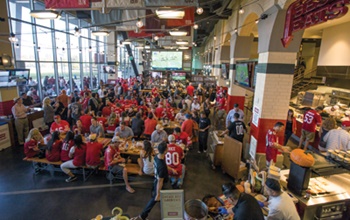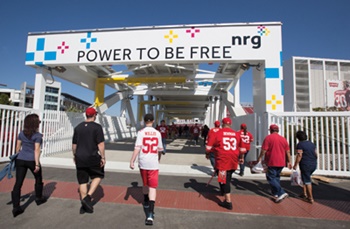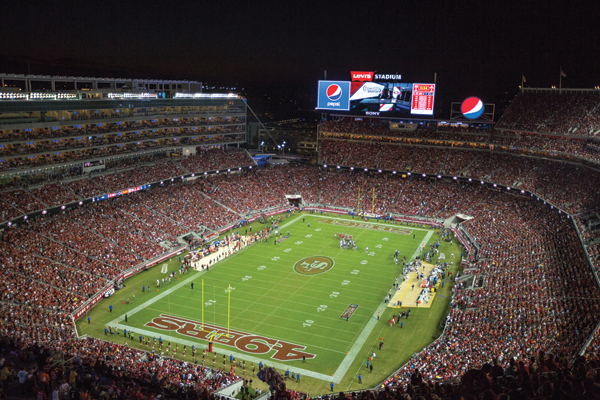 |
The San Francisco 49ers’ new home in Santa Clara, Levi’s Stadium, shone for its Sunday night regular-season opener..
Photo by: VICKI THOMPSON / SILICON VALLEY BUSINESS JOURAN |
Midway through the third quarter of the San Francisco 49ers’ first regular-season game at Levi’s Stadium, a dozen IT guys sat in a conference room inside the Citrix Owners Club, all glued to their laptops.
The room, reserved for running the stadium’s mobile application, is tucked in the northeast corner of the club, where the most expensive suites go for a half-million dollars a year at the team’s new $1.2 billion home. Some in the group wore Niners jerseys and hats. Most had on blue jeans — Levi’s, most likely. At the front of the room, multiple screens flashed real-time data from those in the crowd of 70,000-plus using the app to park their cars, scan their game tickets digitally and order food and drink.
The comfortably casual IT crew looked out of place compared with the wine-and-cheese crowd occupying skyboxes down the hall. But looks can be deceiving. After all, this room represents the nerve center for the next generation of tech-centric NFL stadiums sitting in the heart of Silicon Valley, and these guys are equity partners in VenueNext, the 49ers’ new business venture, a spinoff of the team’s stadium technology division.
For the York family, the 49ers’ owners, it was a no-brainer to develop a tech-savvy stadium in Santa Clara, a city 45 miles south of San Francisco, the team’s home since it was founded in 1946. On average, Bay Area residents spend $1,000 every 18 months on their own personal technology, according to 49ers CEO Jed York, so it was important for the team to meet its fans’ needs while keeping in mind how quickly technology changes.
“When you look at that [trend], you’re talking about $70 million in capital spent on hardware by our fans,” York said. “So I would much rather leverage the great infrastructure here in Silicon Valley as opposed to putting a tablet in everybody’s seat that’s obsolete in 18 to 24 months.”
LEVI’S STADIUM
■ OWNER:
Santa Clara Stadium Authority
■ OPERATOR: San Francisco 49ers
■ COST: $1.2 billion
■ SQUARE FOOTAGE: 1.85 million
■ NAMING RIGHTS: Levi Strauss & Co., 20 years, $220 million
■ SEATS: 68,500
■ SUITES: 176
■ CLUB SEATS: 9,000
■ BRANDED PREMIUM SPACES: SAP Tower, United Club, Levi’s 501 Club, BNY Mellon Club, Brocade Club, Yahoo Fantasy Football Lounge, Citrix Owners Club
■ FOOD, RETAIL CONCESSIONAIRE: Centerplate
■ POINTS OF SALE: 700-plus
■ TEAM STORE: 13,000 square feet
■ RESTAURANT: Michael Mina’s Bourbon Steak & Pub
■ PARKING: 30,000 spaces
■ VIDEO BOARDS: Daktronics
■ TICKETING: Ticketmaster
■ TECHNOLOGY: VenueNext
Sources: 49ers, SportsBusiness Journal research
KEY PEOPLE
SCOTT CAPSTACK
■
Director of design, HNTB
Responsible for designing all premium spaces in Levi’s Stadium as well as sponsorship integration in tandem with Infinite Scale. HNTB’s six-person team also included Fernando Vazquez, Lanson Nichols and Wes Crosby.
JACK HILL
■ Project executive, San Francisco 49ers
Served as the 49ers’ owner’s representative, working with HNTB and the Turner-Devcon joint venture to complete construction in 26 months. The $1.2 billion venue opened a season ahead of schedule.
BRENT SCHOEB
■ Director of corporate partnerships, San Francisco 49ers
Managed the stadium’s founding partner program and the creative process for activating deals such as the Pepsi Fan Deck’s 12-pack seats and Intel Gate A, where Jimmy the Robot will make an appearance later this season.
DAN WILLIAMS
■
Vice president of technology,
San Francisco 49ers
Williams, Facebook’s former director of operations, led work on the facility’s technology platform, which includes the Kezar ticket scanning system and the Levi’s Stadium mobile app.
The tech piece was key, but so was developing a stadium built for sustainability and fan experience. Those were the three themes the 49ers focused on throughout a process dating to the early 2000s, a timeline fraught with stops and starts surrounding 9/11, the Great Recession and battles with the city of San Francisco over building a new facility at the site of Candlestick Park, the team’s home from 1971 through 2013. Ultimately, the 49ers turned to Santa Clara to privately construct a new stadium on a site next to Great America theme park.
The team has a history in Santa Clara, considered the central location for a fan base that has largely moved south from San Francisco to San Jose and Alameda County, where 70 percent of the team’s season-ticket holders reside. Levi’s Stadium connects to the 49ers’ practice facility, which opened in Santa Clara in 1988. A black-and-white photo inside that building shows a young Jed York cutting the ribbon.
The new stadium stands out as the NFL’s first LEED Gold-certified building for new construction. On the NRG Solar Terrace high atop the stadium, the green roof and solar panels point to the team’s commitment to sustainability, York said.
NRG, a founding partner, extends its brand outside the stadium on a pair of bridges topped with solar panels, a first in the NFL. Those green features tie into the 49ers’ attempts to go carbon neutral on game days.
“We want to make sure we’re a leader in that industry as opposed to somebody that just does what is necessary to get by,” York said.
In addition, Levi’s Stadium has a lower bowl with 45,000 seats, the largest in the NFL, a design aspect addressing the fan experience. Yet some observers feel some of the best views of the action and the mountain ranges in the distance lie in the upper deck in both end zones.
Standing there on the Bud Light and Pepsi fan decks looking down on the field gives one a greater sense of the seating bowl’s clean, simple setup. “Kind of collegiate in feeling,” said Jack Hill, the 49ers’ project executive in charge of stadium development.
Its look and feel is a nod to historic Notre Dame Stadium. Both Jed York and his father, 49ers’ co-chair John York, attended Notre Dame; they consider that 84-year-old venue “sacrosanct” and wanted to re-create its intimate feel at the major league level, the junior York said.
In the NFL, Ford Field and Soldier Field served as models for building the SAP Tower on the stadium’s west side containing most of the facility’s 176 suites. Elsewhere, Gillette Stadium and Heinz Field influenced Levi’s Stadium’s two plazas in the northwest and southwest corners.
In the Bay Area, those plaza spaces are sold as standing-room tickets for Niners games and will be converted to temporary seats for Super Bowl 50 and other special events such as WrestleMania and next year’s NHL outdoor game between the San Jose Sharks and Los Angeles Kings.
Separately, Comerica Park, home of the Detroit Tigers, did a great job weaving pieces of city history into the ballpark, York said, inspiring the Niners to do the same thing by incorporating an extensive art program at Levi’s Stadium.
In the Citrix club, a painting of fans watching a game from rooftops across from Kezar Stadium, the team’s home for its first quarter-century, provides one historical touch point. The same is true for a portrait of the “Million Dollar Backfield,” the team’s heralded foursome of the 1950s.
From a sponsor activation standpoint, the branding is subtle in most of the 10 club spaces. One exception is the Yahoo Fantasy Football Lounge. The room’s purple columns jump out, reflecting the founding partner’s color scheme.
Multiple flat-screen TVs inside the lounge form an impressive video ticker tracking NFL player statistics in real time to satisfy season-ticket holders craving up-to-date information on their fantasy teams. The screens also serve as a platform to push Yahoo’s Flickr photo-sharing site and application.
“It’s the mecca of fantasy football information … [a tool for] how to communicate beyond the mobile
device,” said Ethan Casson, the 49ers’ chief revenue officer. “We see this space as popular on non-game days for the ultimate fantasy football draft.”
Levi Strauss & Co., the stadium’s naming-rights holder, brands the 501 Club on the east side opposite the suite tower. The centerpiece is a display of jeans tracking the garment’s evolution over the past 160 years. The back story behind that space dates to
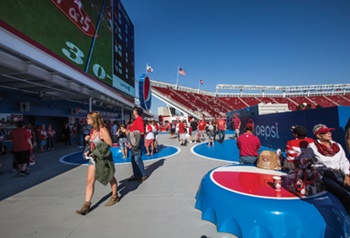 |
From top: Fans pay $5,000 a season for membership to Michael Mina’s Tailgate; founding partner NRG extends its brand outside the stadium to bridges with solar panels; the Pepsi Fan Deck is colorfully branded in the end zone.
Photo by: VICKI THOMPSON / SILICON VALLEY BUSINESS JOURNAL
|
2006 and architect HNTB’s old stadium design, which had all premium inventory on the west side, part of the team’s strategy to push all seats closer to the field.
The 49ers took a closer look at the stadium design a few years later, in part after Legends, the company that Niners Chief Operating Officer Al Guido worked for at the time, came on board to help the team sell suites and club seats.
Together they decided to expand premium seat options to the east side, and architects made room for the 501 Club by designing an elevated structure above the main concourse. Doing so kept the open views to the field as fans walk around the stadium.
It cost more money to make the adjustment, but it was worth it for the 49ers as they look to every revenue opportunity to recoup their investment.
“The 50-yard line is the 50-yard line. It doesn’t matter what side of the building you’re on,” said Al Guido, the 49ers’ chief operating officer. “HNTB did a hell of a job.”
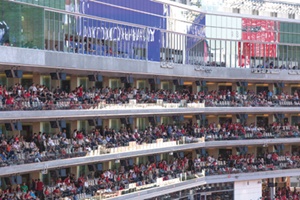 |
The stadium app was used by 33 percent of fans; all premium seating was originally on the west side, but those plans changed.
Photo by: VICKI THOMPSON / SILICON VALLEY BUSINESS JOURNAL
|
For the Sunday night game against the Chicago Bears, many of those premium patrons packed Michael Mina’s Bourbon Steak and Pub, the stadium’s signature restaurant, for a high-end pregame dining experience both inside and outside the eatery.
The 49ers sold all 800 memberships available for Michael Mina’s Tailgate at a cost of $5,000 for the season. Game tickets are not included, but members receive complimentary parking next to the restaurant and other benefits.
The restaurant is open for lunch and dinner during the week. All told, the team’s catering staff has already booked 70 events for the
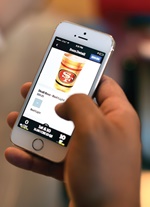 |
Photo by: AP IMAGES
|
season, totaling $5 million in gross revenue between the restaurant and the stadium clubs.
“We think we’ll do upwards of 200 catered events through the course of the season,” Guido said.
Centerplate runs all other food service at the stadium, and back in the corner conference room, the guys with VenueNext reported 3,625 fans ordered food for in-seat delivery and express pickup through the stadium’s mobile app, representing a little more than 5 percent of total attendance. It’s an encouraging beginning for the tech startup.
Overall, 33 percent of 49ers fans used the Levi’s Stadium app to do various things starting from mid-afternoon until late in the game Sunday night. It’s a higher number than other sports venues, which average a little more than 20 percent adoption, according to industry experts.
“We’ve seen very good adoption rates and our number will continue to grow,” York said. “We’re ahead of projections and ultimately we want to get to a place where we have a smart building and everything is digital.”







